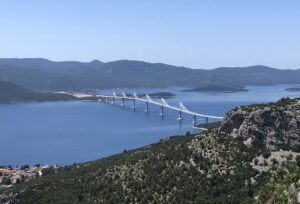In the last 30 years, the Cohesion Fund has invested nearly €179 billion in the economic, social and territorial cohesion of the EU.
Created in the Maastricht Treaty as a necessary complement to the Single Market in the Cohesion Policy toolkit, the Cohesion Fund was given the mission to support investments in transport infrastructure and in climate and environment protection.

Improvement of water supply and waste treatment, energy efficiency, renewable energy and road and rail infrastructure are among its primary targets.
The Fund focus on Member States with a GNI below 90% of the EU average to boost convergence between European economies. Support from the Cohesion Fund, like all funding under Cohesion Policy, have contributed to the rise in national incomes of the beneficiary countries. Ireland and Spain were the first countries that have seen their GNI rise above the eligibility threshold of 90% of the EU average.
Bridges, metros, airports, high-speed trains, and so much more
The Cohesion Fund has financed iconic projects which have transformed entire regions and cities, helping them to catch up with the rest of the EU. For example, in 1998, the Fund supported the construction of the 12.3 km-long ‘Vasco da Gama’ bridge in Lisbon, Portugal, the longest bridge in the EU. It has also supported the ‘Alqueva Dam’ in the Guadiana River, in the south of Portugal, which is one of the biggest water strategic reserves in Europe.
The Fund also played a key role in the development of the Trans-European Transport Network (TEN-T), by supporting the construction and upgrading of 7,800 km TENT-T roads, 3,650 km TEN-T rail and many aqueducts and tunnels. It financed the longest rail tunnel in Southeast Europe, in construction between Elin Pelin – Vakarel – Kostenets in Bulgaria. It also supported the second rail track between Koper (Slovenia’s major Adriatic port) and Divača that will significantly increase freight capacity and ensure the connection to the Austrian rail network.
In Spain the Cohesion Fund helped building the country’s modern high-speed train network. The Madrid–Barcelona–French border high-speed line, with a total length of 804 kilometres, is one of the main communication axes between Spain and the rest of Europe.
Thanks to the Fund, the railway line Warsaw-Gdynia in Poland has improved passenger transport on the Baltic-Adriatic Corridor, while modern rolling stock runs between the main cities of Poland.
The Fund also invested in sustainable public transport in cities, for example in the metro of Warsaw, Budapest, Bucharest, Sofia and Prague. In Bratislava, the Petrzalka tram line with its famous bridge was built with support from the Cohesion Fund.
Moreover, the Fund helped building airports to better connect the Member States which joined the EU in the 2000s. The airports of Tallinn, Warsaw, Wroclaw, and Rzeszow are just some examples.

Addressing climate change and protecting the environment and the health of citizens
The Fund has also supported investments in infrastructure, among them the connection of 6 million people to clean drinking water and 10.5 million people to wastewater treatment. It also supported waste recycling of 4.2 million tonnes of urban waste.
A project of great environmental importance for a green and sustainable economy, that improves the quality of life of thousands of citizens, is the waste treatment plant in Alexandroupolis, in Greece, that allowed for the reduction of 60% in the waste collected from four municipalities of the prefecture of Rodopi and two municipalities of the prefecture of Evros.
The South Sewage Treatment Infrastructure in Malta and the water management for the largest agglomerations in Latvia have improved wastewater treatment and the quality of drinking water for citizens.
In the area of clean energy, the Cohesion Fund supported the installation of renewable energy-using technologies in Lithuania producing electricity for nearly 20,000 households.
The Fund also invested in forest fire protection for 8.3 million people as well as flood protection for 11.4 million people. This includes the construction of a flood protection system and a reservoir to protect the area of Upper-Tisza against floodings of the river Tisza, in Hungary.
Background
The ‘Cohesion financial instrument’, as the Cohesion Fund was initially called, was established on 1 April 1993, and entered into force in 1994 to strengthen the economic, social and territorial cohesion of the EU and the catch-up of countries with the rest of the EU.
The original beneficiaries from the Cohesion Fund were Greece, Ireland, Portugal and Spain (1994-1999); then, since 2004, Cyprus, Czechia, Estonia, Hungary, Latvia, Lithuania, Malta, Poland, Slovakia and Slovenia; Bulgaria and Romania (since 2007); and Croatia (since 2013).
The budget of the Cohesion Fund significantly expanded since the 2004 enlargement: €18 billion in 1994-1999, 30.6 billion in 2000-2006, 68.5 billion in 2007-2013 and 61.4 in 2014-2020.
For the 2021-2027 programming period, more than 37% of the Fund’s €48.03 billion allocation will support climate objectives. This includes €6.9 billion for clean urban transport, €3.3 billion for energy efficiency and €16.9 billion for investments in TEN-T rail and road.
The Cohesion Fund currently benefits 15 Member States with a Gross National Income (GNI) per capita below 90% of the EU average at the time of the 2021-2027 Multiannual Financial Framework agreement: Bulgaria, Czechia, Estonia, Greece, Croatia, Cyprus, Latvia, Lithuania, Hungary, Malta, Poland, Portugal, Romania, Slovakia and Slovenia.
Source: European Commission